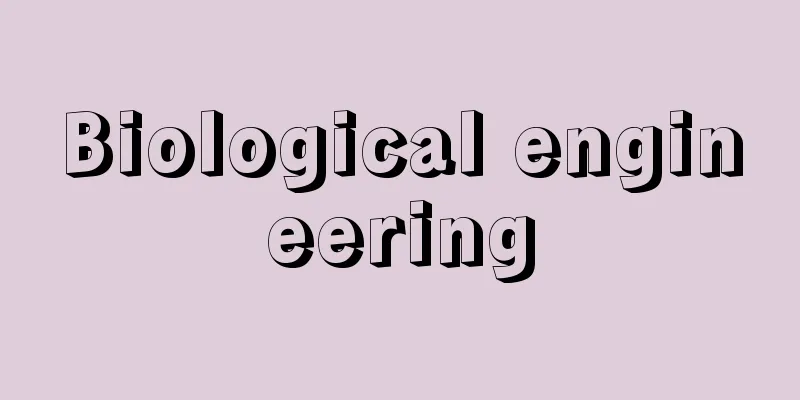Biological engineering

|
This refers to science and technology that artificially manipulates and utilizes the useful characteristics of living organisms, or develops devices that mimic the superior functions of living organisms and perform similar functions. The definition and subject of bioengineering have changed significantly over time and are therefore fluid, but currently it encompasses both a fundamental field that conducts interdisciplinary research in the broad field of life sciences, and an applied field aimed at developing new technologies. Until the 1960s, bioengineering mainly meant microbial engineering. In other words, it is a field that uses bacterial fermentation to develop medicines, foods, seasonings, alcoholic beverages, etc. In addition, with the development of cybernetic thinking and computer technology, since the 1960s, research on artificial intelligence that supports the control technology of robots and rockets, and the field of ergonomics that focuses on human-machine systems that are compatible with human movements have merged. In particular, science and technology that actively seeks to refer to the nervous systems and motor mechanisms of animals to develop new devices with functions that machines previously lacked, such as pattern recognition, logical judgment, and correction and repair through feedback. This field is called bionics. For example, by physiologically elucidating the mechanism of coordinated movements between the eye movements of a frog chasing insects as food and the tongue movements that capture the food, we can obtain hints for creating artificial systems of detectors and effectors with high-level information processing functions. Meanwhile, medical electronics (ME) began to develop from a different perspective, applying electronic engineering technology to the diagnosis and treatment of diseases. In response to this, basic research that uses similar engineering techniques but is not specifically aimed at medical applications came to be called bioengineering, to be distinguished from medical engineering. In the 1970s, bioengineering often referred to this field. Based on control theory and systems theory, bioengineering seeks to understand the harmonious behavior of living organisms by mathematically analyzing the input and output relationships of information. The terms biocybernetics and systems biology are sometimes used interchangeably with bioengineering. From the second half of the 1970s onwards, the scope of bioengineering expanded rapidly, ushering in the heyday of the so-called life sciences. Conventional microbial engineering transformed into genetic engineering. New fields such as developmental engineering, cell engineering and behavioral engineering were developed. The aim here is to artificially manipulate various hierarchical levels of biological structures (genes, fetuses, cultured cells, sex centers, etc.) to create parts or whole organisms with properties that are desirable to humans. In addition, rehabilitation engineering, which deals with the interface between the living body and substitutes for the living body, such as artificial hearts and artificial hands, is also expanding its scope. Therefore, bioengineering in the 1980s can be considered to be related to all fields of biology. [Shojiro Inoue] "Bioengineering: Fundamentals and Methods" by Yoji Umedani (1977, Kyoritsu Shuppan) Source: Shogakukan Encyclopedia Nipponica About Encyclopedia Nipponica Information | Legend |
|
生物がもつ有用な特性を人工的に操作して利用したり、生体の優れた機能をまねて類似の動作を示す機器を開発する科学技術をいう。 生物工学の定義と対象は時代とともに変化が大きく流動的であって、現在では生命科学(ライフ・サイエンス)の広い分野を学際的に研究する基礎的学問と、新しい技術の開発を目的とする応用面とをともに含んでいる。 1960年代までは、生物工学は主として微生物工学を意味していた。つまり、細菌による発酵を利用して医薬品、食品、調味料、アルコール飲料などを開発する分野である。これとは別にサイバネティックス思考やコンピュータ技術の発達とともに、1960年代以降はロボットやロケットの制御技術を支える人工知能の研究や、ヒトの動作に適合した人間―機械系を対象とする人間工学の分野が合流してくる。とくに、それまでの機械に欠けていたパターン認識、論理判断、フィードバックによる修正と修復の機能などを備えた新しい装置を開発するのに、動物の神経系や運動の仕組みを積極的に参考にしようとする科学技術が台頭してきた。この分野をバイオニクスbionicsとよぶ。たとえば、餌(えさ)の昆虫を追うカエルの目の動きと、餌をとらえる舌の運動との協調性のある動作の仕組みを、生理学的に解明することによって、高次の情報処理機能を備えた検出器および効果器の人工システムを製作するためのヒントが得られることになる。 一方これらの分野とは別の観点から、病気の診断や治療に電子工学技術を応用した医用工学(ME, medical electronics, medical engineering)が発達してくる。これに呼応して、同じように工学手法を用いるが、とくに医学への応用を志向しない基礎的な研究を生体工学とよんで医用工学と区別するようになった。1970年代での生物工学はこの分野をさすことが多い。生体工学では、制御理論やシステム理論をもとに、生体の調和のとれたふるまいを情報の入出力関係を数理的に解析することによって理解しようとしている。バイオサイバネティックスbiocybernetics、システム生物学という呼び方も生体工学とほぼ同じ意味で使われることがある。 1970年代後半以降になると、生物工学の対象が急速に拡大し、いわゆるライフ・サイエンスの全盛期に入る。従来の微生物工学は遺伝子工学へと変貌(へんぼう)する。発生工学、細胞工学、行動工学などの新分野が開拓されてくる。ここでは生体構造のいろいろな階層レベル(遺伝子、胎児、培養細胞、性中枢など)で人為操作を加え、人間にとって好ましい性質をもつ生物の一部または全体をつくりだすことが目的とされる。このほか、人工心臓や義手のような生体の代替物と生体との接点を対象とするリハビリテーション工学も領域を広げつつある。それゆえ1980年代の生物工学は、生物学の全分野と関連をもつことになると考えられる。 [井上昌次郎] 『梅谷陽二著『生物工学 基礎と方法』(1977・共立出版)』 出典 小学館 日本大百科全書(ニッポニカ)日本大百科全書(ニッポニカ)について 情報 | 凡例 |
Recommend
Ephoros (English spelling)
[Born] 405 BC. Aeolis, Cyme [Died] 330 BCE An anci...
The big shot problem
…Especially just before his dismissal, Sadanobu s...
The Worship Rebellion - Bohai no Ran
This was a rebellion that occurred in Ningxia Town...
chapter
…the Roman Catholic Church is a body of the Churc...
cocobolo
...It is used for the interior walls of buildings...
Newcomb, TM (English name) NewcombTM
…(2) Research on individual and group behavior Th...
Integralista Party - Integralista Party
A colloquial name for the Brazilian Integralista B...
King Geunchogo
The 13th king of Baekje, Korea (reigned 346-375)....
Papaver
…An annual plant of the Papaveraceae family that ...
Escargot des vignes (English spelling) escargotdesvignes
...A land snail of the family Helicidae, famous a...
Cabriole leg
This refers to a style of furniture leg that curve...
Flower Boar - Kacho
…(6)Chinese: A general term for breeds native to ...
Malus micromalus (English spelling)
…However, unlike apples, the fruit is rarely eate...
Carmen Silva
…He reorganized the Romanian army according to th...
Atropa acuminata (English spelling) Atropaacuminata
…[Hiroshi Aramata]. … *Some of the terminology th...









